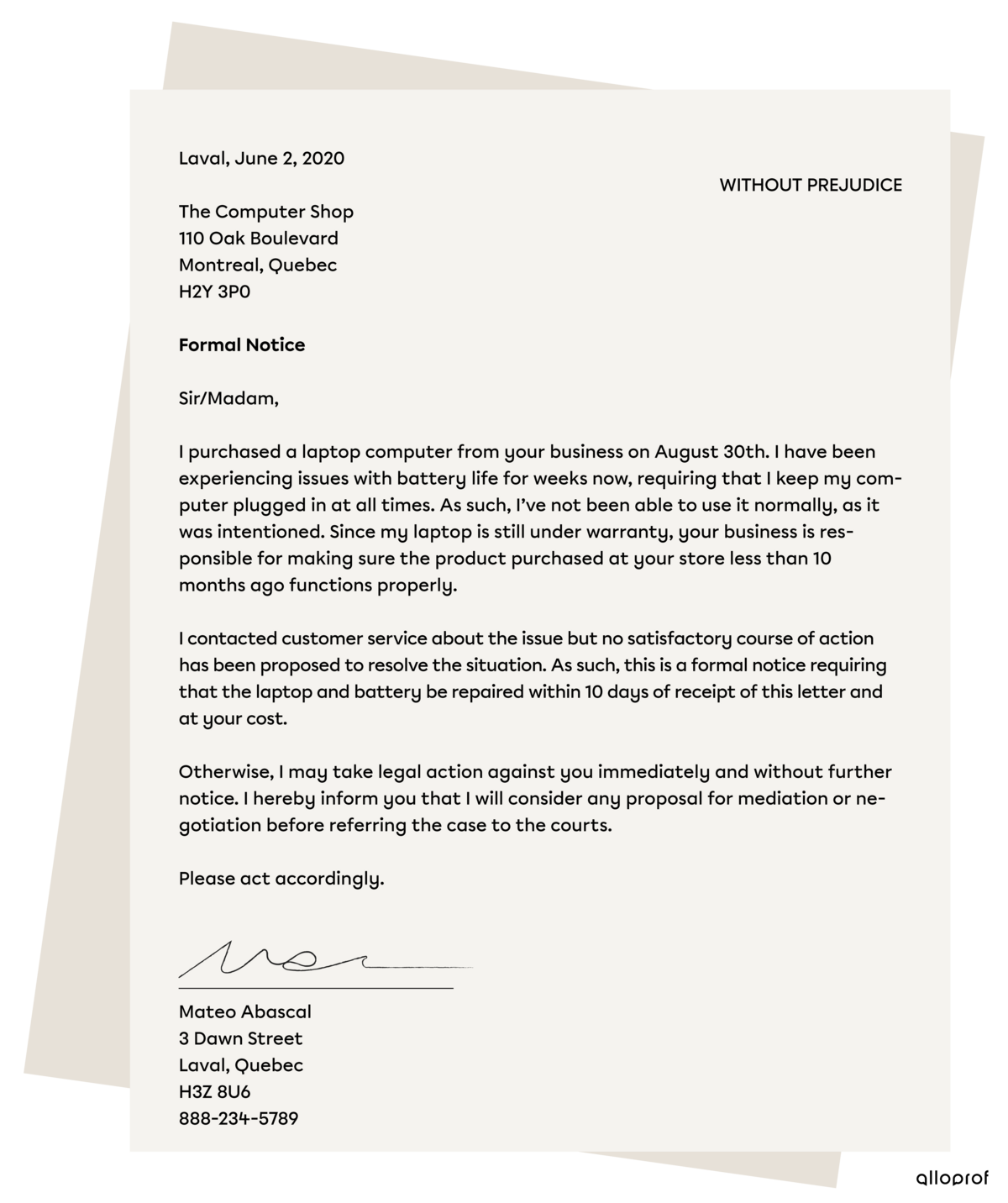An recourse is an appeals procedure undertaken in order to obtain recognition of a right that has not been respected.
Many types of recourse are available to consumers and merchants to protect their rights. These options are like the steps of a ladder: you do not jump straight to the fourth step. You start with the first step and, if the problem is not solved, you go to the second step. You will climb a few steps before reaching the last one, which is Small Claims Court.
Below is a summary of the four main courses of action, in order:
-
the merchant’s customer service
-
the ombudsman
-
the formal notice letter
-
the Small Claims Division of the Court of Québec (Small Claims Court)
If you encounter a problem, make sure you have your proof of purchase (receipts) and your contract, if applicable, before engaging in any recourse action. Make sure you understand the content of your contract.
Mateo bought a good quality laptop a few months ago and uses it to take notes in class and write his lab reports.
He recently started having problems with the battery. Mateo used to be able to use his computer for several hours before having to plug it in and charge the battery. Now, the computer has to be connected to a power source all the time, causing him a lot of headache.
Mateo finds the receipt and the sales contract for the computer. Since the computer is new, he turns to the merchant who sold it to him to find the problem. He contacts the merchant’s customer service department.

Some companies have a dedicated customer service department.
If you have a problem or question, the first step is contacting the customer service department of the company that sold you the goods or services.
One of the goals of customer service is to offer solutions that will satisfy both you and the company. When you contact customer service, be clear when explaining the situation and your expectations. Listen to what is being suggested but remain firm if the customer service suggestion does not meet your expectations. If the negotiation doesn't seem to be going anywhere, you can ask to speak to the company's customer service manager.
If this negotiation fails, find out about the company’s complaint process. Filling out a complaint form or writing a letter of complaint can help you convince the company and lead to an agreement.
The Office de la protection du consommateur suggests a few steps to take when negotiating with a merchant.
Mateo outlines his situation to the customer service representative and what he wants the merchant to do: take back his computer and fix his battery problem.
After some discussion, the representative suggests that Mateo send his computer to the merchant’s service centre, where specialists can evaluate his computer and repair it.
This is not to Mateo’s advantage because he has to pay to ship his computer to the service centre and for the time the technician needs to repair it. The merchant will only pay for the parts needed for the repair and the cost of sending the computer back to Mateo.
Mateo tries to negotiate with the representative to lower the amount he has to pay since his computer is still new and he has taken good care of it. The merchant, according to the legal guarantee, is responsible for repairing or replacing a good that no longer works as it should after a short period of time. Mateo makes this point to the representative and to the head of the customer service department, but they both say there is nothing more they can do.
Mateo asks about the complaint process, hoping that filling out the complaint form will help resolve the situation.
If your efforts with the company do not solve the situation, turn to the ombudsman.
Some large companies and most public organizations give you access to an ombudsman, who investigates complaints that have been filed. This is why it is important to go through the complaint process. The ombudsman will consider the claim, the evidence you provide to support your claim and consider the company’s or organization’s side of the story. The purpose of the process is to have the ombudsman assess the merits of your complaint and propose a solution to the dispute through negotiation. The ombudsman may make suggestions to the company or organization to resolve the dispute.
The names used vary from one organization to another: ombudsman, mediator or consumer protector.
Not all companies or organizations have employees in this role. If the complaint process has failed to resolve the situation, you will have no choice but to prepare a formal notice.
If your previous efforts have not led to an agreement with the merchant, your next recourse is a formal notice letter that sets out what is expected of the merchant to correct the situation and provides a deadline for the solution. It is a mandatory step and a last chance to resolve the situation without having to go to court.
Remember that your letter must be clear and that it must set out the most important points of your demands. The form and contents of this type of letter must follow a certain structure. Here is a list of the main elements to include in a formal notice letter.
In the header:
-
The words without prejudice in the upper right-hand corner to allow you to add certain details in case there is a hearing in Small Claims Court
-
The date, time and place the letter was written
-
The name and contact information of the merchant or person to whom the letter is addressed
In the body of the letter:
-
A detailed description of the problem, putting the events into context and including dates, to the extent possible
-
A clear demand regarding how the merchant or person can or should resolve the problem
-
A reasonable timeframe for resolving the problem. This is often within 10 days, but can be longer depending on the situation
-
The actions that will need to be taken
-
Your signature and contact information (address and phone number)
-
The list of attachments to the letter (photos or documents to support the claim)

You must be able to prove that the merchant or person received your formal notice letter and the date on which it was received. A good way of doing this is sending the letter by registered mail. That way you will have a signature to confirm receipt of the letter and the date of delivery. Keep a copy of the letter for future reference.
The Ministère de la Justice du Québec and Éducaloi have templates to help you write a formal notice letter. If you have any questions, you can also call the Office de la protection du consommateur.
A formal notice is a recourse you can use as a consumer to appeal to the merchant to correct a situation if they have not fulfilled their obligations. It is also a recourse that the merchant can use when a consumer does not respect a signed contract.
Mateo moves on to the next step because the merchant does not have an ombudsman and the complaint form did not improve the situation. He writes and sends a formal notice to the merchant. The letter clearly, but briefly, presents the situation. The letter also states how the merchant can resolve the situation. He gives the merchant 10 days to respond to the formal notice.
Mateo receives confirmation that the letter was delivered to the merchant on June 5th. Eight days later, he receives a call from the merchant’s customer service department. The merchant agrees to cover all costs for the shipping and repair of the computer.
A few weeks later, Mateo receives his computer with the defective battery replaced and everything working fine. The different remedies Mateo used took time and energy but, in the end, the legal guarantee was respected. Gone are the days of searching for a power outlet for his computer!
If no agreement had been reached after the formal notice was sent, Mateo could have taken his case to the Small Claims Division of the Court of Québec. This is the final recourse for consumers and merchants for any claim under $15,000.
This remedy is commonly called Small Claims Court. It is the last recourse to use when nothing else has led to an agreement. It handles disputes for claims up to $15,000.
You do not need to be represented by a lawyer in Small Claims Court. You can represent yourself, because it is a court that is accessible to everyone. However, it is a good idea to ask for information and advice before filing a claim.
The decisions made by this court are final. This means the courts’ decision cannot be appealed. Whether the decision is positive or negative, you must respect it.
On the Ministère de la Justice website, there is a different tools for preparing and filing claims in Small Claims Court.
As with the formal notice letter, Small Claims Court is a recourse that both consumers and merchants can use to exercise their rights.
Collectif, Mes dossiers. Manuel de l’élève, p.35-39
Collectif, Finances en jeu. Manuel de l’élève, p.90-95